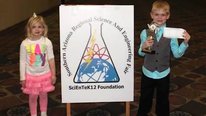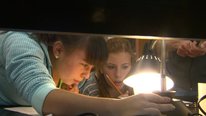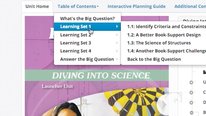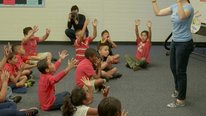NSF Awards: 1251611
The ambitious changes in one’s teaching practice called for in the Common Core and NGSS are complex, for teachers and their students. Together these changes invite the progressive building of ideas and capacities – over months or years, not days. As a result, the field of STEM learning is being challenged in multiple ways. For professional development designers a major challenge, simply put, is this: It is hard to teach what one cannot even imagine.
Our ongoing work with the Next Generation Science Exemplar (NGSX) model of PD suggests that strategic use of high quality “educative” video cases of Framework and NGSS aligned teaching and learning, and working with curriculum storylines can be essential in meeting this challenge, closing the gap between imagining and realizing. Video cases and follow-on curriculum storylines, if designed to be educative, will provide equitable access for science educators, regardless of content background, to major science ideas and practices identified in the Framework and NGSS.
What makes a PD tool “educative”? It is designed to be a “thinking device” requiring significant intellectual engagement, provoking discussion, analysis and knowledge building with colleagues. These tools support teachers by showing them what changes in 3-D science can look and sound like in their own classrooms. And they help teachers adapt curriculum materials to support coherence and “figuring out” rather than “learning about.” Through a step-by-step experience of assembling educative materials with PD colleagues or adapting units already in use, they become critical consumers of other curriculum units.









Deborah Hanuscin
This is really exciting work— I’m interested in learning more about your storyline tools and how those support teachers in becoming more critical consumers of curriculum materials, and how that helps them adapt what they find to meet the NGSS.
Brian Reiser
Professor, Learning Sciences
You can find out a bit more about the storyline tools here http://www.nextgenstorylines.org/ along with some sample storylines and associated lesson plans.
In NGSX, in the introduction to 3D learning pathway, we have a multi-day unit devoted to understanding the issues of coherence in NGSS aligned lessons. We support participants in unpacking DCIs to get to the implicit knowledge in the DCI needed to develop explanatory ideas. Activities support participants in developing phenomena and associated questions that would be both amenable to investigation, and would help students build the key pieces of the DCIs and crosscutting concepts. Activities then support participants in developing assessment tasks and sample student products, that get them to think deeply about what it would look like, in students’ words, to meet the performance expectation. The goal of the unit is to involve participants in the kind of thinking they need to do to adapt existing materials and build science and engineering practices into lessons, so that students are genuinely working to explain phenomena or solve problems, rather than just going through the motions.
Jean Moon
President
As Brian describes in the posting above, the educative goal in working with storyline tools has a multiplier effect. The progressive development of explanatory ideas as NGSX participants (adult learners) guides/informs participant thinking about what this process would look like in their classroom, with students, working to explain phenomena or solve problems.
Sarah Gerard
Education Researcher
Really important and exciting work that you’re doing. Have you been collecting data from the participating teachers about their perceptions or other metrics?
Brian Reiser
Professor, Learning Sciences
Sarah thanks for your comment. Yes, we have been collecting data from participating teachers along a number of dimensions — shift in attitudes and beliefs related to NGSS pedagogy, ability to engage in modeling, explanation and argumentation in the area of matter themselves, and shifts in pedagogical content knowledge. You can find a recent paper from NARST from our group presenting an empirical study of teacher growth http://bit.ly/1MLVVLA
Jessica Ashley
NGSX (and Facilitators Training)… the best professional learning I’ve ever engaged in! I can’t see learning science any other way. Excited to lead a cohort this summer!
Jean Moon
President
Jessica, thanks so much for your comment. And we are excited along with you as you step into your NGSX facilitator role in Michigan. Best wishes!
Sarah Michaels
Professor of Education, Senior Research Scholar, Hiatt Center for Urban Education
I too appreciate your testimonial, Jessica. It was a privilege to work with you in MI, and to learn from you. Part of what makes NGSX great is the people who have been through the pathway, and then become peer-leaders, as you are. Looking forward to hearing from you how leading your own NGSX study group goes this summer.
Kelly Pudelek
Survey Specialist
Great work! What are some of the challenges of implementing the new curriculum materials in the classroom after using these tools?
Rebecca Lowenhaupt
This is exciting work! It seems like you’ve been drawing on best practices for supporting adult learning and helping teachers integrate these new ideas into their own contexts. I wonder if you’ve considered the role of school leaders in supporting this type of learning opportunity? Have supervisors or principals participated in any of these efforts? It seems like they might be a help or hindrance, as teachers try to adapt their practice.
Jean Moon
President
You are asking a great question, Rebecca, thank you. Inclusion of instructional leaders in the K-12 system is so critical as teachers need support to make these complex shifts to their practice. We are now in the process of designing a component to our NGSX learning system that will focus on building knowledge among instructional leaders, especially as they observe classrooms and conference with teachers about the Framework and NGSS. For example, when core practices are introduced in a classroom what might this instructional shift look like or sound like? What are students doing? So stay tuned, we expect to be sharing the design of this instructional leader component as it becomes more fully developed and operationalized. Our work with educative video will play a central role in this new work. Again, thanks for your question.
Rebecca Lowenhaupt
That sounds great—yes, video is very effective as a way for supervisors to practice observing/giving feedback of instruction. Maybe we can share some of our work with you, too, as we’ve been developing materials for supervision of the science practices. I’d love to hear your thoughts about our project, Instructional Leadership for Science Practices.
Sarah Michaels
Professor of Education, Senior Research Scholar, Hiatt Center for Urban Education
Rebecca, we’re aware of the fantastic work you’re doing with Kate McNeil, and we’d love to see more. I’m very impressed with your website and your Showcase video! I teach at Clark and live in the Boston area, so we should definitely set up a time to confer, share our respective work (and struggles), and think together.
Marian Pasquale
Senior Research Scientist
Helping teachers adapt existing materials is the way to go. I’m thinking that with the diversity of curriculum materials in schools, from textbooks to kit-based programs, some teachers will have a harder time of adapting their lessons. have you found this to be the case?
Sarah Michaels
Professor of Education, Senior Research Scholar, Hiatt Center for Urban Education
Marian, this is a great question and a great issue to explore in depth. In the NGSX Teacher 3-D Learning Pathway, the final “Unit” (Unit 7) focuses on bringing NGSS and all that’s been learned in Units 1-6 back into one’s own classroom. Units 1-6 take approximately 30 hours of engaged face-to-face study group time, and Unit 7 is an additional 3-day unit (approximately 24 hours). In NGSX, we bring together K-12 teachers in the same face-to-face study groups. But unlike Units 1-6, where teachers collaborate across grade bands (with elementary, middle, and high school teachers working side-by-side in all activities), in Unit 7 teachers work in grade-band aligned design teams within their study group. In Unit 7, they begin the process of developing a “mini-unit” of curriculum that is appropriate for their own students, focusing on science content that they will actually teach, and is fully aligned with NGSS and the Framework. But it’s important to note that the goal of this “mini-unit” design work is not to create a “ready-to-use” unit of instruction (3 days is simply not long enough to accomplish this). Rather the goal is give participants a robust experience of “thinking like an NGSS curriculum designer” – so that they have very developed capacities, tools, and practical experience to draw on in thinking critically about ANY piece of curriculum they encounter, or adapt, or design with colleagues. In other words, the goal of Unit 7 is to help teachers develop their NGSS muscles so that they are very critical consumers of other people’s curricula, well-informed adapters of text-book or kit-based units of instruction, and effective colleagues in co-designing, adapting, and reflecting on the enactment of a unit of instruction, with other teachers. Having said all this, Unit 7 is new – still in the field test and revision stage – though we have implemented it (in beta form) in 3 states, with over 500 teachers. We haven’t systematically followed these teachers back into their own classrooms, so we don’t know if it’s been harder for some than others to implement or adapt curriculum (or even their own mini-units). We are, of course, very interested in finding out how these teachers fare, if they do further develop and implement their Unit 7 mini-unit, and how they approach other curriculum (whether they traditionally have used textbooks or kits or neither), and what factors might affect how easy or hard it is to adapt/use/design NGSS-aligned curricula. We are gathering anecdotal responses, and building toward more systematic research efforts on this issue. We’ll keep you posted as we learn more about the challenges teachers face in adapting/using/sharing curriculum after NGSX!
Suzanna Loper
Really exciting and essential work! I hope you are able to continue to expand the reaches of this project to support more teachers.
Sarah Michaels
Professor of Education, Senior Research Scholar, Hiatt Center for Urban Education
Thanks, Suzanna, for your encouraging words. We are working hard to do just that — expand the reaches of NGSX, by working with actors as change agents across the entire system — state leaders, K-12 science teachers (with our 3-D Learning Pathway) teacher leaders and PD providers (with our Facilitator Pathway), and now we are beginning to design an Instructional Leadership Awareness Course — to help building-based and district-based instructional leaders support teachers who are working hard to understand and enact the new vision of 3-D teaching and learning in science. We find that if we focus on only one or two levels of the system, the work is not sufficiently supported, and less sustainable. And of course, we have to work simultaneously on professional learning opportunities, NGSS-aligned curriculum for all grades or grade-bands, and both formative and high-stakes assessment practices. It’s a tall order, but the possibilities are amazing.
Jean Moon
President
I want to convey my appreciation as well, Suzanna, for your post. Sarah has done a thorough job of detailing how we are “expanding the reaches” of NGSX. Our work with states is giving us good insight into the systemic challenges and opportunities for states to use NGSX as a model of PD in their scaling process. Also our work with building a national network of NGSX facilitators affords yet another “reaching out/expanding” opportunity. Thanks again.
Pat Fitzsimmons
NGSX is changing the way that teachers think about teaching science in their classrooms. The rich experiences that are woven throughout the Learning and Facilitator Pathways as well as opportunities to engage in deep, meaningful discourse provide extremely powerful learning opportunities for educators. Vermont has been very fortunate to be one of the states that has piloted and provided feedback on both pathways. We look forward to scaling up these efforts and reaching even more educators. Additionally, we’ve had the good fortune of working closely with Brian, Sarah, and Jean and benefiting from their expertise.
Jean Moon
President
Thank you, Pat, for your affirming comments. Our piloting and developmental work in VT has been central to working through the concept of educative video as a robust tool to support science educators. So a big thanks to you and all of your VT and VSI team!!
Further posting is closed as the showcase has ended.